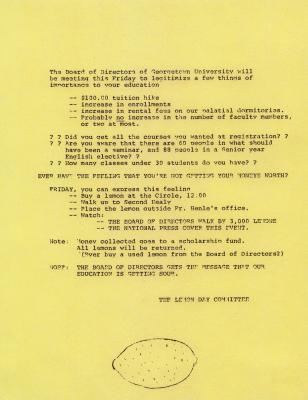The Lemon Day Protest was a student protest against tuition and fees increases in 1973. Students piled lemons in front of Fr. Robert Henle, S.J.'s office to protest the university's decision.
Background and protest
On February 2, 1973, the Georgetown Board of Directors met to consider a proposed tuition hike, increased enrollment, and higher dormitory fees. Notably absent was a proposal to also increase the number of faculty positions. Faced with higher costs and overcrowding in classrooms, the library, and dormitories, Georgetown students organized what is now known as the famous “Lemon Day Protest” or “Lemon-stration.”1 A student committee arranged the sale of 3,000 lemons in Healy Circle for students to pile in front of the Office of the University President — then occupied by Fr. Robert Henle, S.J. — to protest the way in which the University education was “going sour.”2
Student Body President John Kennedy (COL ‘73) accompanied the protests with a letter to the Board of Directors. In it, he wrote, “while you could dismiss ‘Lemon Day’ as a funny student stunt, I think I speak for the student body when I say that the connotation … that our education is going sour is a real feeling on the part of every student.”3 Additionally, the Student Academic Board presented six solutions to the increasing enrollment problem: (1) “hire more graduate students which will remove some of the faculty burden,” (2) “use more of the Consortium programs,” (3) “accept transfer students only in departments with small class size,” (4) “reallocate existing faculty positions,” (5) “hire more faculty,” and (6) “freeze enrollment immediately.”4
Impact and legacy
At the end of the day, the lemons were sold back to the fruit dealer, and the organizers donated the profits from the sale to the community scholars fund. Unfortunately, fundraising for the community scholars fund was Lemon Day’s biggest success. The Board of Directors approved the controversial budget that increased tuition and dorm rates. The Board Chairman, Fr. Albert Jonsen, S.J., referred to the protest as “imaginative and amusing” but claimed that the directors heard the message and “appreciate the concern for cost and quality of education at Georgetown.” 5Nevertheless, Fr. Jonsen wanted students that they should expect necessary tuition increases for the next three to four years.
Academic Vice President Fr. Thomas Fitzgerald, S.J. also announced that three additional part-time faculty positions had been approved, recognizing that the appeals by Georgetown students “have not fallen on deaf ears; they are heard and understood in a broad context of the pressures from our recent past and our hopes for Georgetown's future.”6
- 1“Von Hagen, Mark. “Students Set Academic Protest.” The Hoya. 2 Feb. 1973, p.1, 12.
- 2Telerski, Noah and Shore, Cade. “Having a Grand Old Time: News on the Hilltop from 1969 to 2009.” The Georgetown Voice. 3 April 2019.
- 3Id.
- 4“Students Set Academic Protest,” p.12.
- 5Von Hagen, Mark. “Board OK's Budget; Tuition, Housing Up With More to Come.” The Hoya. 09 Feb. 1973.
- 6Id.



